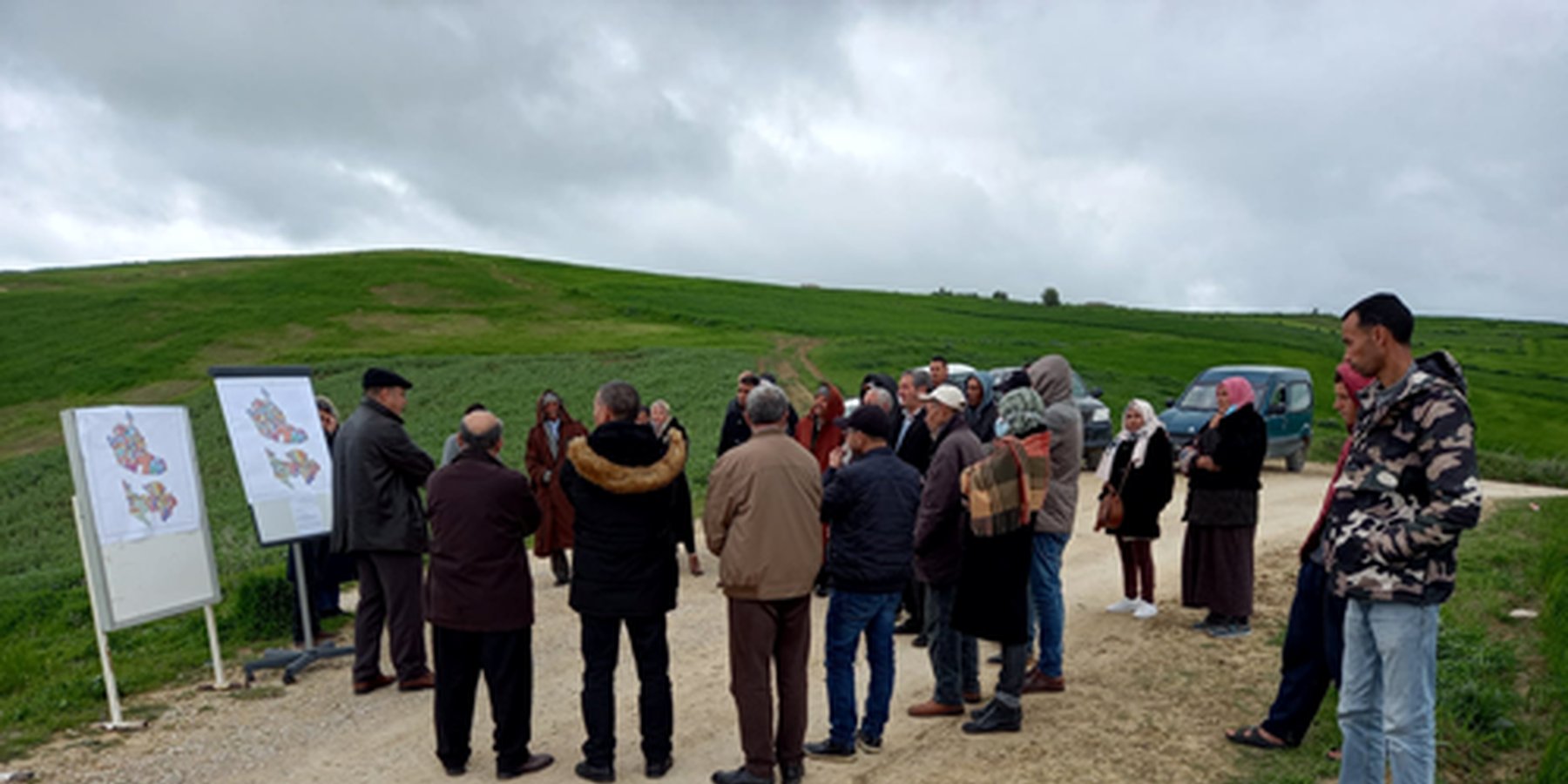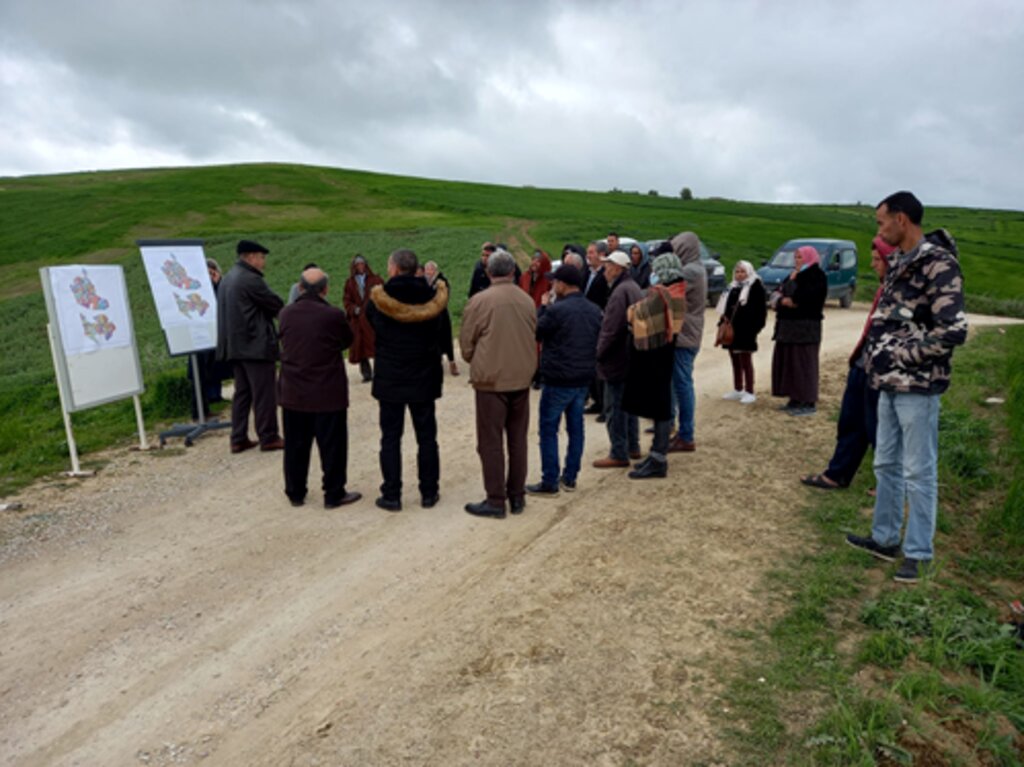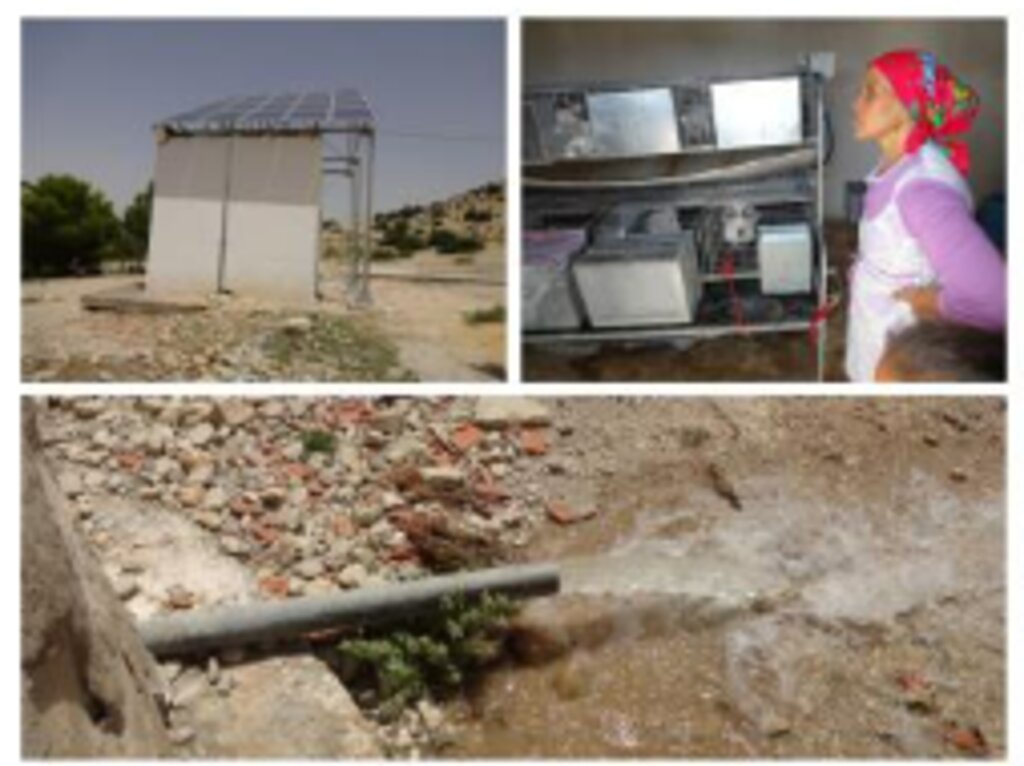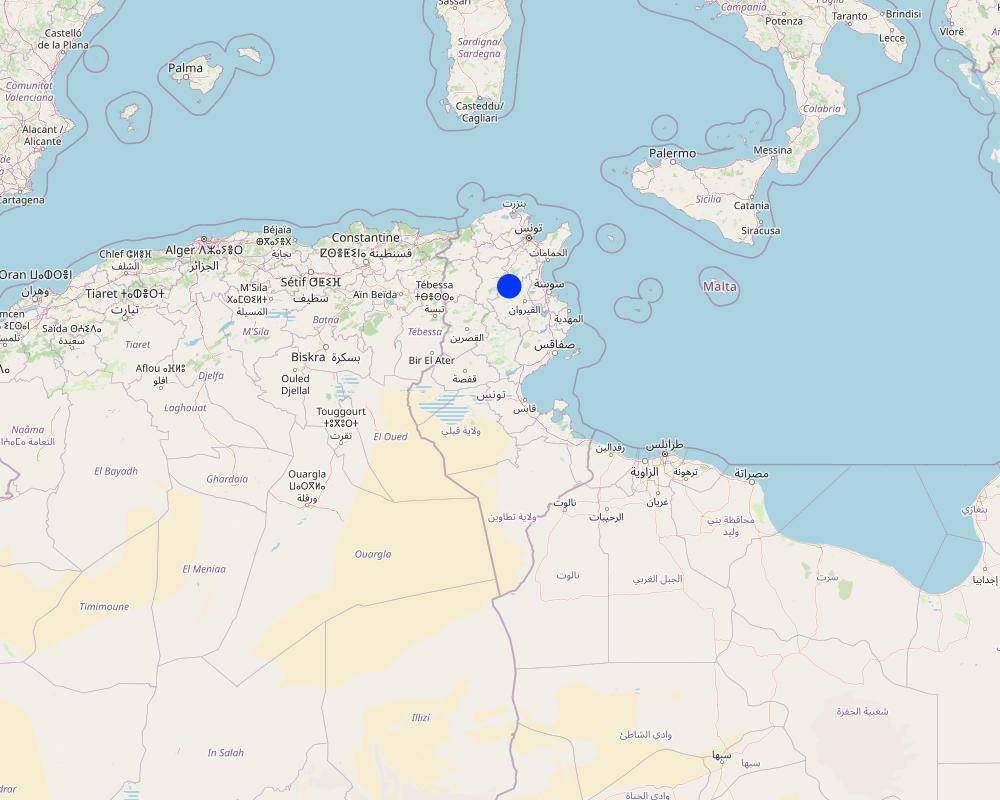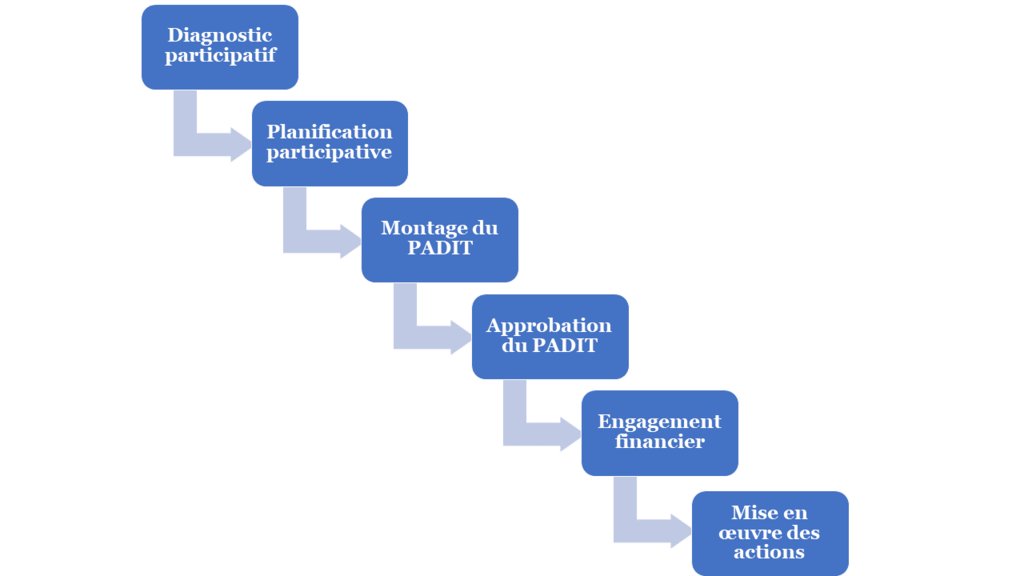Integrated Territorial Planning and Development Project (PADIT) [Tunisia]
- Creation:
- Update:
- Compiler: Wafa Saidi
- Editors: Siagbé Golli, Faouzi Harrouchi, faouzi BATTI, Fatma Maaloul, Tabitha Nekesa, Ahmadou Gaye
- Reviewers: William Critchley, Rima Mekdaschi Studer
approaches_6593 - Tunisia
View sections
Expand all Collapse all1. General information
1.2 Contact details of resource persons and institutions involved in the assessment and documentation of the Approach
SLM specialist:
SLM specialist:
Name of project which facilitated the documentation/ evaluation of the Approach (if relevant)
Soil protection and rehabilitation for food security (ProSo(i)l)Name of the institution(s) which facilitated the documentation/ evaluation of the Approach (if relevant)
Direction Générale de l’Amenagement et de Conservation des Terres Agricoles (DG/ACTA) - TunisiaName of the institution(s) which facilitated the documentation/ evaluation of the Approach (if relevant)
Deutsche Gesellschaft für Internationale Zusammenarbeit, Tunisia (GIZ Tunisia) - Tunisia1.3 Conditions regarding the use of data documented through WOCAT
When were the data compiled (in the field)?
03/01/2023
The compiler and key resource person(s) accept the conditions regarding the use of data documented through WOCAT:
Yes
1.4 Reference(s) to Questionnaire(s) on SLM Technologies
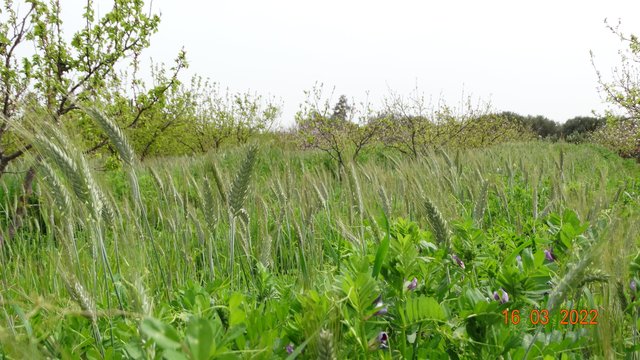
Meslin: Mixed crops of cereals and legumes [Tunisia]
Meslin consists of a planting mix of cereals and legumes, formulated for both livestock feed and soil rehabilitation purposes.
- Compiler: Wafa Saidi
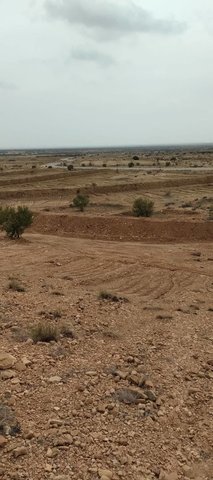
Biological consolidation of mechanical benches with olive trees [Tunisia]
The biological consolidation of embankments is an agricultural practice that entails planting embankments with arboricultural, pastoral, or forage species. This cultivation technique enhances the effectiveness and longevity of these structures.
- Compiler: Wafa Saidi
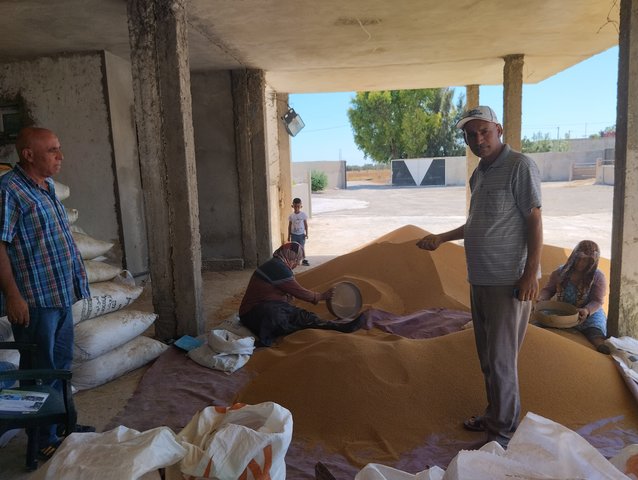
Seed Cleaning and Treatment [Tunisia]
In Tunisia, ensuring a consistent supply of quality forage and pasture seeds to farmers is a critical hurdle in advancing the livestock industry, with many farmers turning to self-produced seeds to fulfil their requirements.
- Compiler: Wafa Saidi
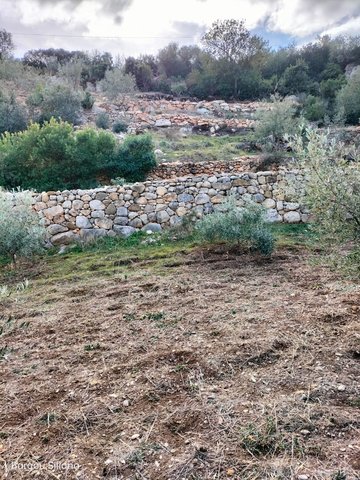
Dry Stone Walls [Tunisia]
Dry stone walls are durable landscaping structures created by arranging stones to construct small walls (without cement or plaster) either following contour lines or approximately perpendicular to the slope.
- Compiler: Wafa Saidi
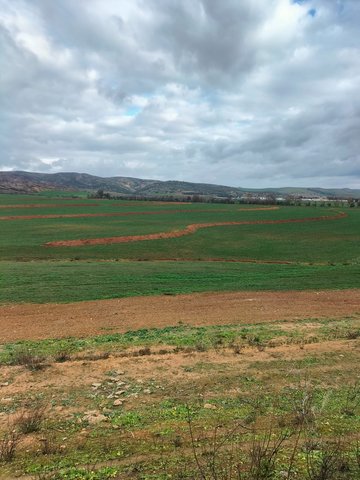
Mechanical Benches [Tunisia]
Mechanical bench terraces are a landscaping technique employed on sloping terrain. These are essentially mechanically constructed earthen levees or embankments established along contour lines.
- Compiler: Wafa Saidi
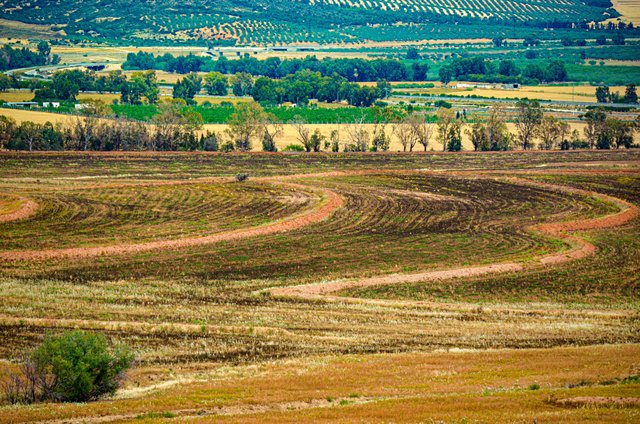
Contour tillage [Tunisia]
Contour ploughing is an agricultural technique involving the cultivation of sloping land along contour lines. This technique creates a succession of closely spaced ridges and furrows which help to retain water and soil.
- Compiler: Wafa Saidi
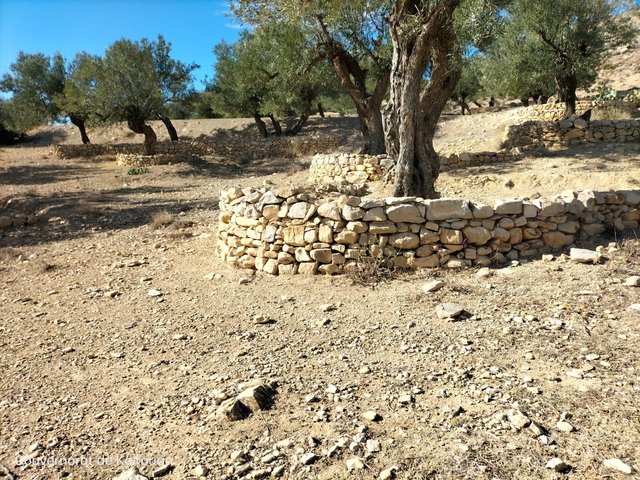
Individual Dry-Stone Basins [Tunisia]
Individual dry-stone basins are a traditional runoff water collection technique built in dry stone around the trunk of trees, mainly olive trees.
- Compiler: Wafa Saidi
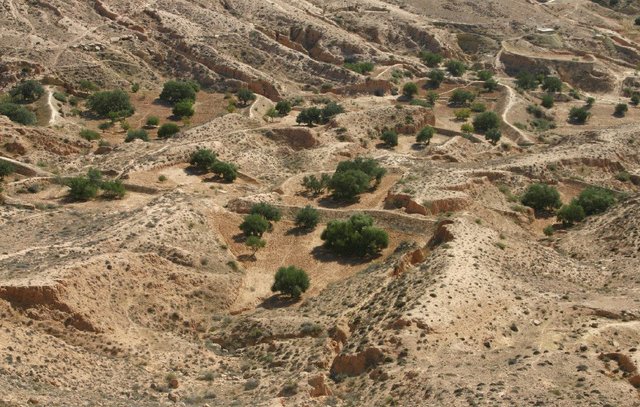
Jessour [Tunisia]
Jessour is an ancient runoff water harvesting technique widely practiced in the arid highlands
- Compiler: Mongi Ben Zaied
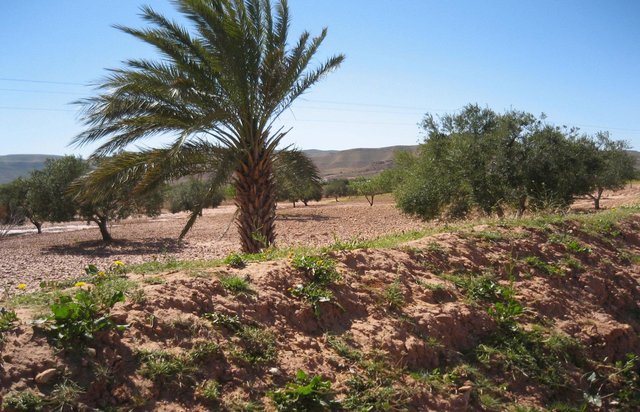
Tabia [Tunisia]
The tabia earthen dyke is a water harvesting technique used in the foothill and piedmont areas.
- Compiler: Mongi Ben Zaied
2. Description of the SLM Approach
2.1 Short description of the Approach
The PADIT approach comprises a cross-cutting participatory methodology to rural development, rallying various stakeholders around a project, within a location, to identify the main economic areas of the rural community concerned, and draw up a prioritized list of actions to strengthen and support development efforts in their location.
2.2 Detailed description of the Approach
Detailed description of the Approach:
The Directorate-General for the Development and Conservation of Agricultural Lands uses a cross-cutting participatory approach to rural development (Integrated Territorial Planning and Development Project or "PADIT"), rallying various stakeholders around a project, within a location (often a subsection of a municipality or imada), with the aim of identifying the main economic areas of the rural community concerned, and drawing up a prioritized list of actions to strengthen and support development efforts in their location. This approach aims to promote integrated rural development and sustainable management of natural resources.
The overarching aim is to establish and/or fortify the core economic activities that empower communities to maximize the assets and potential of their area. Simultaneously, the strategy endeavours to reinforce the connection between the population and their local environment.
Implementation stages:
1. Participatory diagnosis: This stage focuses on understanding the dynamics of the area, identifying strengths and weaknesses. The Rural Development Support Officer (CADR) plays a crucial role in organizing the population, delineating the intervention territory, identifying local potential, and fostering collaboration among the residents. This phase also encourages the emergence of rural development projects with a focus on soil and water conservation.
2. Participatory planning: This stage is based on collective feedback workshops to validate the diagnosis and collect action proposals from residents and regional experts.
3. Preparation of the PADIT: This stage translates the main concerns of rural communities into a programme of action and a financing plan. It outlines the individual and collective investments necessary to achieve social and economic objectives.
4. Approval of the PADIT: The PADIT is presented to local stakeholders for their approval.
5. Financial commitment: Various partners commit to financing the actions outlined in the PADIT (national budget, regional budget, additional funding from donors, etc.). This commitment is formalized through a Unitary Financial Programming Document (DOCUPF).
6. Implementation: This approach relies on active participation from the local community in the planning process, complemented by technical assistance from local, regional, and central government authorities. The Rural Development and Support Officer (CADR) is a well-trained technician responsible for coordinating activities within the territory and facilitating communication among various stakeholders.
2.3 Photos of the Approach
2.5 Country/ region/ locations where the Approach has been applied
Country:
Tunisia
Region/ State/ Province:
Zaghdoud, Oueslatia, Kairouan
Map
×2.6 Dates of initiation and termination of the Approach
Indicate year of initiation:
2017
2.7 Type of Approach
- project/ programme based
2.8 Main aims/ objectives of the Approach
This new approach meets several objectives:
- Rational management of natural resources;
- Integrated, participatory development of rural areas;
- Involvement and empowerment of the population throughout the planning process.
2.9 Conditions enabling or hindering implementation of the Technology/ Technologies applied under the Approach
social/ cultural/ religious norms and values
- enabling
The geographical area of intervention covers a portion of a municipality or imada
availability/ access to financial resources and services
- enabling
- This approach is implemented within the framework of a project.
- The signing of a single financial programming document (DOCUPF) is a commitment by the partners to finance the activities.
institutional setting
- enabling
Various entities and institutes are involved in this process.
collaboration/ coordination of actors
- enabling
Involvement of various stakeholders in natural resources management and agricultural development
at the central, regional and local levels.
legal framework (land tenure, land and water use rights)
- enabling
Tunisia has adopted a new legal investment framework.
- hindering
- Most agricultural lands need to be reorganized.
- The inapplicability of the Water and Soil Conservation (CES) Code (Act no. 95-70 of July 17, 1995).
policies
- enabling
- Decentralization is a key component of projects
land governance (decision-making, implementation and enforcement)
- enabling
Decentralization of government bodies and involvement of local and regional bodies in decision-making and implementation of the new economic and social development model.
knowledge about SLM, access to technical support
- enabling
The Rural Development Support Officers (CADR) play an important role in knowledge production and dissemination.
3. Participation and roles of stakeholders involved
3.1 Stakeholders involved in the Approach and their roles
- local land users/ local communities
The local population
- Participation in territorial diagnosis.
- Proposal of actions including a CES component.
- Participation in the decision-making process.
- Participation in planning meetings.
- community-based organizations
- Local government
- Participation in planning meetings.
- Participation in the decision-making process.
- SLM specialists/ agricultural advisers
-Rural Development Support Officer
- Support for community/citizen organization.
- Rural development animation.
- Knowledge dissemination.
- Liaison between the administration, the territorial committee and the local population.
- researchers
Research institutions
- Institutional and scientific support through expertise and innovation.
- Technical advice on proposed actions.
- Support for action proposals.
- teachers/ school children/ students
Teachers
- Technical advice on proposed actions
- NGO
- Support for the local population.
- Support for decision-making.
- private sector
- Entrepreneur
- Company
- Support for financing initiatives
- local government
- Participation in planning meetings.
- Participation in the decision-making process
- national government (planners, decision-makers)
Ministries (Finance, Agriculture, Development, etc.)
- Participation in planning meetings.
- Participation in the decision-making process
- Participation in financing initiatives
- international organization
- Participation in financing.
- Institutional and scientific support.
3.2 Involvement of local land users/ local communities in the different phases of the Approach
| Involvement of local land users/ local communities | Specify who was involved and describe activities | |
|---|---|---|
| initiation/ motivation | interactive | A series of meetings and interviews with the local population are held from the outset of the project, as part of the diagnosis of the area of intervention. |
| planning | interactive | The local population is involved in all phases of planning: proposing actions, prioritizing actions, locating actions, etc. |
| implementation | interactive | - Supporting the implementation of certain actions: selection of beneficiaries. |
| monitoring/ evaluation | self-mobilization | Ownership of actions and participation in monitoring and evaluating their implementation |
3.3 Flow chart (if available)
Description:
The implementation of the PADIT requires an understanding of the territory's assets and challenges during the diagnostic phase. Following the diagnosis, all stakeholders become involved in the planning process by proposing actions and geolocating them. The experts then set about drawing up the PADIT, assessing the feasibility of the proposed actions and estimating their cost. This document must be validated by the stakeholders before the partners make a commitment to finance it, in order to guarantee its implementation.
Author:
Wafa SAIDI
3.4 Decision-making on the selection of SLM Technology/ Technologies
Specify who decided on the selection of the Technology/ Technologies to be implemented:
- all relevant actors, as part of a participatory approach
Explain:
All stakeholders are involved in the entire planning process.
Specify on what basis decisions were made:
- evaluation of well-documented SLM knowledge (evidence-based decision-making)
- research findings
- personal experience and opinions (undocumented)
4. Technical support, capacity building, and knowledge management
4.1 Capacity building/ training
Was training provided to land users/ other stakeholders?
Yes
Specify who was trained:
- land users
- field staff/ advisers
If relevant, specify gender, age, status, ethnicity, etc.
40% of participants are women
Form of training:
- farmer-to-farmer
- demonstration areas
- public meetings
- courses
Subjects covered:
- Technical assistance and support for farmers and microproject beneficiaries.
- A two-day training course on participatory diagnosis methods and tools was organized for subject specialist technicians at national (DG-ACTA), regional and local levels (including CES, forestry, OEP, PV and CTV), community representatives, civil society and local authorities (OMDA).
- Training in facilitation and conflict management.
- Training on business plan preparation.
4.2 Advisory service
Do land users have access to an advisory service?
Yes
Specify whether advisory service is provided:
- on land users' fields
- at permanent centres
4.3 Institution strengthening (organizational development)
Have institutions been established or strengthened through the Approach?
- yes, greatly
Specify the level(s) at which institutions have been strengthened or established:
- local
- regional
- national
Describe institution, roles and responsibilities, members, etc.
CRDAs and CTVs
Specify type of support:
- capacity building/ training
Give further details:
Capacity-building for CRDA and CTV staff (Rural Development Support Officer)
4.4 Monitoring and evaluation
Is monitoring and evaluation part of the Approach?
Yes
Comments:
Monitoring the implementation of the action plan involves three key mechanisms:
-Central monitoring of the action plan for new strategy implementation, which is overseen centrally
-Monitoring of CES action programs, which is conducted by the organization responsible for piloting the program. These action programs concern the PADITs carried out in prioritized zones, emergency works (such as one-off projects or the rehabilitation of existing structures posing a threat), works that have been rehabilitated before transfer to non-state managers, as well as activities related to animation, extension, training, and technical assistance
-Impact monitoring and evaluation
If yes, is this documentation intended to be used for monitoring and evaluation?
Yes
Comments:
Monitoring and evaluation of the development process
4.5 Research
Was research part of the Approach?
Yes
Specify topics:
- sociology
- ecology
- technology
Give further details and indicate who did the research:
Development of applied research :
- on water and soil conservation, with demonstration plots
- to assess the micro-economic impact of SLM work on farms over the medium and long terms
5. Financing and external material support
5.1 Annual budget for the SLM component of the Approach
If precise annual budget is not known, indicate range:
- 100,000-1,000,000
Comments (e.g. main sources of funding/ major donors):
DGACTA, OEP, "Participation of the Local Population in the Management of Natural Resources upstream of the Nebhana Dam" project
5.2 Financial/ material support provided to land users
Did land users receive financial/ material support for implementing the Technology/ Technologies?
Yes
5.3 Subsidies for specific inputs (including labour)
- equipment
| Specify which inputs were subsidised | To which extent | Specify subsidies |
|---|---|---|
| machinery | fully financed | 25% for the purchase of tractors, combine harvesters and all types of towed and self-propelled equipment. |
- agricultural
| Specify which inputs were subsidised | To which extent | Specify subsidies |
|---|---|---|
| seeds | partly financed | Seeds are subsidized by OEP |
| fertilizers | partly financed | Fertilizers are subsidized by the DGPA |
- infrastructure
| Specify which inputs were subsidised | To which extent | Specify subsidies |
|---|---|---|
| roads | fully financed | |
| schools | fully financed | |
If labour by land users was a substantial input, was it:
- paid in cash
Comments:
CES worksites (paid per working day)
5.4 Credit
Was credit provided under the Approach for SLM activities?
No
5.5 Other incentives or instruments
Were other incentives or instruments used to promote implementation of SLM Technologies?
No
6. Impact analysis and concluding statements
6.1 Impacts of the Approach
Did the Approach empower local land users, improve stakeholder participation?
- No
- Yes, little
- Yes, moderately
- Yes, greatly
Land users and stakeholders are involved at every stage of the process.
Did the Approach enable evidence-based decision-making?
- No
- Yes, little
- Yes, moderately
- Yes, greatly
Concerted planning.
Did the Approach help land users to implement and maintain SLM Technologies?
- No
- Yes, little
- Yes, moderately
- Yes, greatly
Did the Approach improve coordination and cost-effective implementation of SLM?
- No
- Yes, little
- Yes, moderately
- Yes, greatly
Did the Approach mobilize/ improve access to financial resources for SLM implementation?
- No
- Yes, little
- Yes, moderately
- Yes, greatly
Involving the various stakeholders in the planning phase can facilitate access to financial resources. A funding commitment document is signed by the partners.
Did the Approach improve knowledge and capacities of land users to implement SLM?
- No
- Yes, little
- Yes, moderately
- Yes, greatly
Meetings provide an opportunity to exchange information, and training sessions are organized.
Did the Approach improve knowledge and capacities of other stakeholders?
- No
- Yes, little
- Yes, moderately
- Yes, greatly
Participation in training sessions.
Did the Approach build/ strengthen institutions, collaboration between stakeholders?
- No
- Yes, little
- Yes, moderately
- Yes, greatly
Collaboration charter
Did the Approach mitigate conflicts?
- No
- Yes, little
- Yes, moderately
- Yes, greatly
Did the Approach empower socially and economically disadvantaged groups?
- No
- Yes, little
- Yes, moderately
- Yes, greatly
The intervention areas are socially and economically disadvantaged territories.
Did the Approach improve gender equality and empower women and girls?
- No
- Yes, little
- Yes, moderately
- Yes, greatly
Involving rural women in the planning process
Did the Approach encourage young people/ the next generation of land users to engage in SLM?
- No
- Yes, little
- Yes, moderately
- Yes, greatly
Did the Approach improve issues of land tenure/ user rights that hindered implementation of SLM Technologies?
- No
- Yes, little
- Yes, moderately
- Yes, greatly
Involvement of the Agricultural Land Agency
l'implication des directions chargées par l'eau et l'assainissement
Did the Approach improve the capacity of the land users to adapt to climate changes/ extremes and mitigate climate related disasters?
- No
- Yes, little
- Yes, moderately
- Yes, greatly
Agroecology
Did the Approach lead to employment, income opportunities?
- No
- Yes, little
- Yes, moderately
- Yes, greatly
6.2 Main motivation of land users to implement SLM
- increased production
Intensification of agricultural production
- increased profit(ability), improved cost-benefit-ratio
- Creation of working days
- Harvesting zgougou and rosemary, among others
- reduced land degradation
Water and soil conservation measures are implemented to reduce land degradation
- affiliation to movement/ project/ group/ networks
Providing training for young individuals and granting them access to micro-projects to empower them to establish initiatives and income-generating activities, ultimately enhancing their quality of life. This initiative not only brings about a transformative dynamic to the entire area but, most importantly, fosters the integration of young people into the broader community.
- environmental consciousness
- enhanced SLM knowledge and skills
Technical assistance and training sessions
6.3 Sustainability of Approach activities
Can the land users sustain what has been implemented through the Approach (without external support)?
- yes
If yes, describe how:
Benefits of training and technical assistance
6.4 Strengths/ advantages of the Approach
| Strengths/ advantages/ opportunities in the land user’s view |
|---|
| Participation in planning |
| Strengths/ advantages/ opportunities in the compiler’s or other key resource person’s view |
|---|
| Guarantees the sustainability of the technologies implemented |
| Technical and methodological capacity building |
6.5 Weaknesses/ disadvantages of the Approach and ways of overcoming them
| Weaknesses/ disadvantages/ risks in the land user’s view | How can they be overcome? |
|---|---|
| Limited finance | Donor involvement and commitment to financing more activities |
| Weaknesses/ disadvantages/ risks in the compiler’s or other key resource person’s view | How can they be overcome? |
|---|---|
| Involvement of the public | Choosing a focus group that influences the majority of the population and works for the common good |
7. References and links
7.1 Methods/ sources of information
- interviews with SLM specialists/ experts
Five experts were interviewed
- compilation from reports and other existing documentation
7.2 References to available publications
Title, author, year, ISBN:
Stratégie pour l’Aménagement et la Conservation des Terres Agricoles (ACTA) à l’horizon 2050, Direction Générale d'Aménagement et de Conservation des Terres Agricoles, 2017
Available from where? Costs?
Ministry of Agriculture, Directorate-General for the Development and Conservation of Agricultural Lands
Title, author, year, ISBN:
Rapport Plan participatif de gestion des eaux et des sols , Projet « Participation de la population locale à la gestion des ressources naturelles en amont du système hydraulique Nebhana», La Zone Zaghdoud-Oueslatia - Kairouan,2018
Available from where? Costs?
Ministry of Agriculture, Directorate-General for the Development and Conservation of Agricultural Lands
Title, author, year, ISBN:
Guide des procédures du PADIT, AFC Agriculture and Finance Consultants GmbH (AFC), 2023
Available from where? Costs?
Ministry of Agriculture, Directorate-General for the Development and Conservation of Agricultural Lands
Links and modules
Expand all Collapse allLinks

Meslin: Mixed crops of cereals and legumes [Tunisia]
Meslin consists of a planting mix of cereals and legumes, formulated for both livestock feed and soil rehabilitation purposes.
- Compiler: Wafa Saidi

Biological consolidation of mechanical benches with olive trees [Tunisia]
The biological consolidation of embankments is an agricultural practice that entails planting embankments with arboricultural, pastoral, or forage species. This cultivation technique enhances the effectiveness and longevity of these structures.
- Compiler: Wafa Saidi

Seed Cleaning and Treatment [Tunisia]
In Tunisia, ensuring a consistent supply of quality forage and pasture seeds to farmers is a critical hurdle in advancing the livestock industry, with many farmers turning to self-produced seeds to fulfil their requirements.
- Compiler: Wafa Saidi

Dry Stone Walls [Tunisia]
Dry stone walls are durable landscaping structures created by arranging stones to construct small walls (without cement or plaster) either following contour lines or approximately perpendicular to the slope.
- Compiler: Wafa Saidi

Mechanical Benches [Tunisia]
Mechanical bench terraces are a landscaping technique employed on sloping terrain. These are essentially mechanically constructed earthen levees or embankments established along contour lines.
- Compiler: Wafa Saidi

Contour tillage [Tunisia]
Contour ploughing is an agricultural technique involving the cultivation of sloping land along contour lines. This technique creates a succession of closely spaced ridges and furrows which help to retain water and soil.
- Compiler: Wafa Saidi

Individual Dry-Stone Basins [Tunisia]
Individual dry-stone basins are a traditional runoff water collection technique built in dry stone around the trunk of trees, mainly olive trees.
- Compiler: Wafa Saidi

Jessour [Tunisia]
Jessour is an ancient runoff water harvesting technique widely practiced in the arid highlands
- Compiler: Mongi Ben Zaied

Tabia [Tunisia]
The tabia earthen dyke is a water harvesting technique used in the foothill and piedmont areas.
- Compiler: Mongi Ben Zaied
Modules
No modules


